Author: New interdisciplinary Brownfields course offered by ENVE
original post: http://cbi.uconn.edu/course-information/
Is this relevant to Connecticut and potential job opportunities?
Connecticut has a rich industrial history, which has resulted in thousands of abandoned sites throughout the state. The investigation, remediation and redevelopment of these sites requires skilled personnel in environmental law, financial and real estate analysis, land use and urban planning, public policy, environmental science and engineering and landscape architecture.
The course will bring students in contact with active professionals and CT municipalities, who will provide practical knowledge of the process, with real world examples
What can I expect to learn in this course?
The course will provide practical knowledge of the following topics:
- Environmental Law and Regulatory Framework
- Financing of real estate development and brownfields, funding sources and process
- Urban planning: zoning, decision making process
- Site investigation and remediation: overview of the different phases and factors
- Policy: how do municipalities make decisions and what are operational aspects influencing the process
- Community involvement and Environmental justice
What is the follow up practicum course?
In the Spring semester, students who took ENVE 3995 may elect to enroll for a follow up practicum, during which they will work with CT municipalities on a specific aspect of real brownfield project, helping the communities identify sources of funding and potential end uses, create wide area plans, prioritize sites, conduct a Phase I investigation or write grant proposal, to mention a few example of potential projects. Students will be supervised by professionals from the CBI partners, who span the range of relevant fields and have years of experience with projects in Connecticut and elsewhere. The practicum will offer students further opportunities for internships and hands on experience and interaction with future employers.
Is this a course only for engineers?
No. Brownfield redevelopment has an engineering component, but the course will provide an overview of all related aspects, including legal, socioeconomic, and science and engineering issues.
There are no prerequisites for the course and it is open to all majors. Juniors and seniors are encouraged to participate, but sophomores may also take it.
How can I register for the course?
For Fall 2018, the course is offered as ENVE 3995 Special Topics in Environmental Engineering: Brownfield Redevelopment
3 credits, Meeting times Tu Th 3.30-4.45
How can I get credit for the course and the follow up practicum in my major?
You will have to discuss this with your academic advisor, depending on your program requirements. Some information for selected majors follows.
Environmental Engineering students: you can use ENVE 3995 as Area 5 Professional Elective. The practicum course may be taken as an independent study for free elective credits.
Civil Engineering students: you can use ENVE 3995 as one of the additional Professional Requirements. The practicum course may be taken as an independent study for free elective credits.
Environmental Studies students: ENVE 3995 may be used as Major Elective, while the practicum portion may qualify for EVST 3991 Internship credits.
Environmental Science students: ENVE 3995 maybe used for credits in the Sustainable Systems concentration and the practicum portion can qualify for internship credits.
Author: 4th SAGE Annual Poster Competition, Cash Prizes!
Please see the following flyer for more information.

Author: E.G. ENVE Ph.D. student wins prestigious student paper award at AGU conference

Farzaneh MahmoodPoor Dehkordy (Environmental Engineering PhD candidate) has received the Outstanding Student Paper Award (OSPA) at American Geophysical Union (AGU) Fall meeting 2017. OSPA is awarded to promote and reward high quality student research and presentation skills. Farzaneh is mentored by Professor Amvrossios Bagtzoglou (Head of Department and Professor of Civil and Environmental Engineering) and Dr. Martin Briggs (USGS Research Hydrologist and Adjunct Professor of Civil and Environmental Engineering). Dr. Frederick Day-Lewis (USGS Research Hydrologist) is also a co-author of the work presented in AGU. Farzaneh’s research is about experimental and numerical analysis of less-mobile domain processes in naturally occurring porous media. Her research is funded by the NSF project: “Revealing the Role of Less-Mobile Porosity in Hyporheic Denitrification and Greenhouse Gas Production”. This is Farzaneh’s second year in a row to win the OSPA award.
Author: Webinar: New Distance Learning Program on Contaminated Site Remediation

Friday, February 9th, 12:00 p.m. to 1:00 p.m.
The Continuing and Distance Engineering Education (CDEE) program gives students the ability to pursue a masters level degree in several engineering concentrations, to improve their skills in cutting-edge subject areas through our certificate programs, or to develop in-depth knowledge in areas tailored to their needs or the needs of their employers.
Please join us on Friday, February 9th from 12:00pm-1:00pm for our Continuing and Distance Engineering Education webinar to learn about our Master of Engineering Contaminated Site Remediation degree and our Contaminated Site Remediation Advanced Engineering Certificate that allow professionals to enhance their skills based on employer needs:
Please follow the link below for additional information and to rsvp for the event.
https://secure.engr.uconn.edu/forms/contaminated-site/remediation/
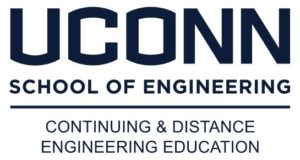
Author: Brownfield Remediation gets Groundswell of Support from UConn
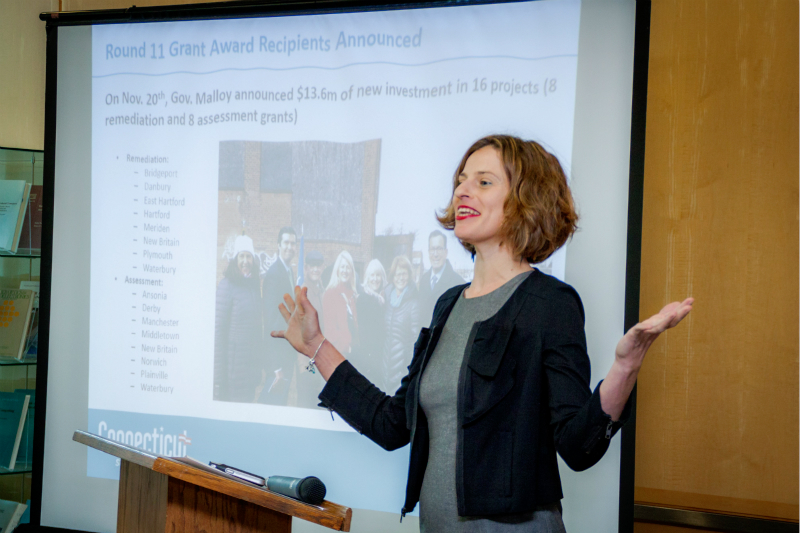
Maria Chrysochoou, associate professor of civil and environmental engineering and director of the new Connecticut Brownfields Initiative. (Christopher Larosa/UConn Photo)
Connecticut’s municipalities are dotted by hundreds of brownfield sites with remnants of toxic chemicals and industrial waste from years of unregulated activity. Federal and state assistance is available for cleanup, but the expertise and resources for the intensive process to secure those funds are not.
UConn’s new Connecticut Brownfields Initiative aims to bring much-needed assistance to the redevelopment of these sites.
“Different municipalities have different levels of readiness and resources,” says Maria Chrysochoou, associate professor of civil and environmental engineering and director of the new initiative. “Cities like Stamford and Bridgeport have built up the staff and expertise to successfully go through the process. But smaller towns sometimes don’t have the resources to put together winning proposals, which impedes their economic development opportunities.”
In order to develop a workforce and provide assistance to Connecticut towns and cities, the Connecticut Brownfields Initiative will develop a top-notch program for education on brownfields remediation and redevelopment, and provide networking opportunities for students, municipalities, and industry partners.
Beginning in the Fall 2018 semester, students will be able to enroll in a class that will teach them grant proposal writing, regulatory and liability issues, site investigation and remediation, and many other topics surrounding brownfields.
Click here to read more on UConn Today.
Author: Using Social Media to Take on Climate Change
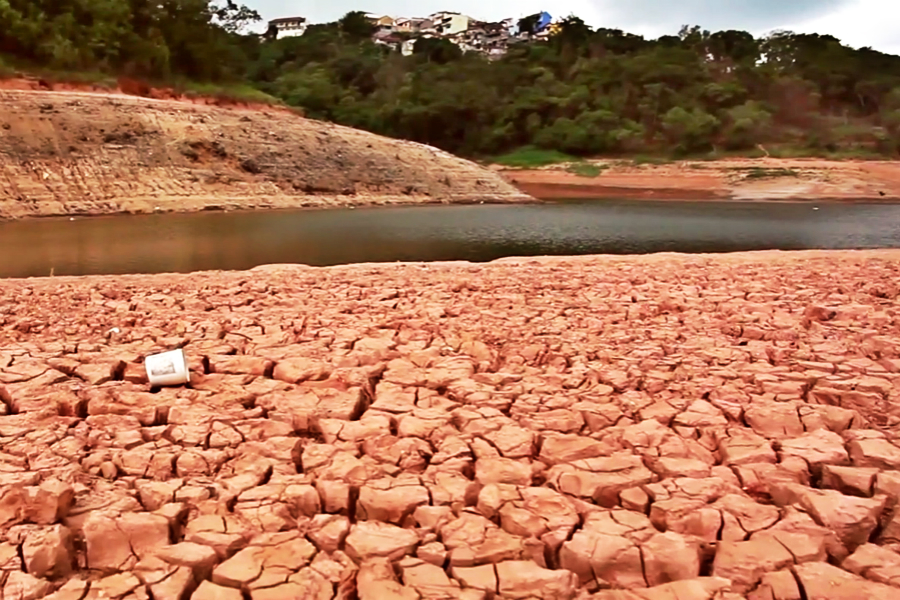
Two UConn graduate students who are passionate about climate change are on a mission to change the world one video at a time.
On a typical Friday night, most graduate students would be thinking about their weekend plans to see friends and blow off steam. Instead two UConn Ph.D. candidates are devoting their downtime to tackling climate change one video at a time.
Lori Fomenko and Amir Erfanian, both from UConn’s Department of Civil and
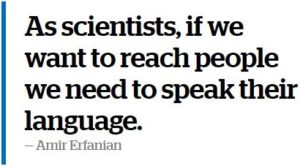
Environmental Engineering, started the ClimaMedia project a little less than a year ago. Since then, they have produced half a dozen videos simplifying highly technical climate change research so that the general public can understand and, hopefully, act.
As scientists and millennials, Fomenko and Erfanian saw a huge gap between how the scientific community shares news about their discoveries and the way people consume content in the digital age. While the majority of Americans report being interested in new scientific discoveries, only about 2 percent of annual news coverage between 2007 and 2012 focused on science and technology, according to a report by the National Science Foundation (NSF).
“Every year, billions of taxpayer dollars fund research, but the outcome of all that hard work and money is a 10-page paper written for the author’s peers,” says Erfanian. “This information is important for the public, but it’s not written for them. As scientists, if we want to reach people we need to speak their language.”
The inspiration for the ClimaMedia project came after Fomenko traveled to Australia and was shocked by the change she saw in the Great Barrier Reef. At the same time, Erfanian read a recent research paper about climate change and coral bleaching. The problem was that the research paper was too technical for most people to understand. The two had an idea to help make that information accessible to the general public.
“I saw how my friends and family, many of them non-scientists, reacted to the news of the Great Barrier Reef destruction. They were devastated. This real world example of how climate change impacts the things we take for granted turned theory into reality. They finally got it, ” says Fomenko. “We decided to produce videos that help more people ‘get it’ by translating technical science into everyday language, images, and topics that show the impact climate change is already having on our daily lives.”
Each week, Fomenko and Erfanian pick two or three recent research papers that discuss topics relating to climate change with an immediate, tangible impact on people. With help from the scientists who authored the selected papers, they set to work creating a simple story line. Then they pick appropriate open source video clips to accompany simple text to explain the complex research findings. Each video is about one-minute long and can be played without sound.
To share their work, the team relies on popular social media platforms like Twitter and Facebook, in the hope that important climate research will go viral.
So far, Fomenko and Erfanian have covered several topics that they feel could strike a cord with viewers, like warming temperatures in Alaska, hurricane forecasting, and poverty due to climate change. The Guardian, a British daily newspaper with a U.S. edition, recently featured a ClimaMedia video on extreme droughts in South America based on research that Erfanian, Fomenko, and their advisor, Professor Guiling Wang conducted through a grant from the National Science Foundation (NSF).
Wang explains how the use of video breaks language barriers, not only to translate technical to non-technical terminology, but also in a literal sense.
“After the publication of The Guardian article, I received interview requests from Germany, Brazil, and Australia. Although some of the resulting news pieces were written in languages foreign to me, they still included the ClimaMedia video. It shows that people don’t need to speak the language in order to understand the concept. The graphics convey the message to a wider audience and broaden the reach of study findings.”
The ClimaMedia team feels they have proven their concept, since analytics indicate that videos are most popular among the groups who are directly affected by the topic at hand. For instance, their video about the effects of sea level rise on urban populations was most viewed by 13 to 17 year olds in Indonesia. According to many studies, Indonesia is particularly vulnerable to damage from sea level rise due to climate change. Experts predict that some 2,000 Indonesian islands could be washed away as early as 2030.
Currently Fomenko and Erfanian are trying to increase resources for the project so that they can offer student internships, pay for subscriptions for access to better video content, and expand current marketing campaigns. They also hope to expand the scope of research featured in ClimaMedia videos to cover other fields, such as health and biotechnology.
“What Lori and Amir have been able to accomplish with ClimaMedia is not only impressive, it’s inspirational,” says Radenka Maric, UConn’s vice president for research. “We can learn a lot from our student researchers. They are the future of scientific research, they make a difference each day, and we need their help to more effectively communicate and have an impact.”
ClimaMedia is just the beginning for Fomenko and Erfanian. Their real goal is much bigger.
“We want to change the world,” Fomenko explains. “Acknowledging that there is a gap between research and the public is just the first step. To get people to act, to get them to change, that’s just as important as making a huge scientific breakthrough.”
Watch Fomenko discuss the challenges of communicating science in a UConn TedX talk, The Changing Face of Media: How Science is Left Behind.
Erfanian, Wang, and Fomenko’s study on extreme drought featured in The Guardian was originally published in Scientific Reports. The project was funded by the National Science Foundation (AGS-1063986) and the UConn Institute of Biological Risk.
Original press: http://today.uconn.edu/2017/10/using-social-media-take-climate-change/
Author: Entry Level Engineering position at RI DEM Site
Job Opportunities Page
| Job Title: | SANITARY ENGINEER | |
| Department: | DEPARTMENT OF ENVIRONMENTAL MANAGEMENT | |
| Division: | Waste Management | |
| Opening Date/Time: | Wed. 08/30/17 12:00 AM Eastern Time | |
| Closing Date/Time: | Fri. 09/08/17 11:59 PM Eastern Time | |
| Salary: | $29.02 – $32.51 Hourly $52,821.00 – $59,162.00 Annually |
|
| Pay Grade: | 327 A | |
| Job Type: | Council 94 (2-36) | |
| Bargaining Union: | Council 94 Local 2881 (13) | |
| Location: | 235 Promenade Street, Providence, Rhode Island | |
| Scheduled Work Days; Hours of Work Unclassified; Standard: | Monday – Friday; 8:30AM – 4:00PM | |
| Work Week: | Standard 35.0 Hours | |
| Assignment(s)/Comments: | This federally funded will be assigned to the federal site remediation unit in the Office of Waste Management, as well as work in contaminated sites under the federal CERCLA and Superfund grants. POSITION RE-POSTED – PREVIOUS CANDIDATES NEED NOT RE-APPLY. | |
| Job #: | 1758-50101-69 | |
| Class Definition Benefits Supplemental Questions
|
| GENERAL STATEMENT OF DUTIES: To assist a superior by performing the less complex engineering tasks in the field of sanitary engineering; and to do related work as required.
SUPERVISION RECEIVED: Works under the general supervision of a superior from whom general and specific work assignments and instructions are received with some latitude for the exercise of independent judgment; work is reviewed in process and upon completion for application of accepted sanitary engineering methods and techniques. SUPERVISION EXERCISED: As assigned, may supervise the work of others engaged in making sanitary inspections. |
| Illustrative Examples of Work Performed: |
| To assist in the promotion of the establishment of safe drinking water supplies and make periodic determinations of the sanitary quality of all public water supplies; when requested, to determine the sanitary quality of private and industrial water supplies. To make surveys for certification to the appropriate federal agency of the sanitary quality of all water supplies and the sanitation of all watering points used by interstate carriers. In a program for the control of stream, lake, and tidal water pollution; to make field surveys to determine the degree of pollution, including the collection of physical data and the making of chemical determinations in the field; to make laboratory examinations of samples of water, sewage, and industrial waste; to make field surveys of the sources of pollution and their magnitude; to analyze the survey data and to assist in the planning of the highest future sanitary condition of the waters of the State that can be feasibly attained; to assist in determining the sewage and industrial waste treatment facility projects needed to achieve the planned condition. To assist in determining the sanitary condition of shellfish grounds and, on the basis of such determinations, to assist in the regulating of the taking of shellfish therefrom. To assist in the study and in the preparation of reports on the engineering plans of private, municipal, and industrial waste treatment systems essential to the prevention of water pollution; to assist in the study and preparation of reports on engineering plans for private, municipal, or industrial sewage disposal systems not essential to the prevention of water pollution, but necessary to avoid the establishment of unsanitary or unhealthful conditions. To make surveys and determinations of the sanitary quality of the waters of all bathing areas and to assist in the control of other phases of environmental sanitation. To assist in the preparation of engineering testimony for presentation at hearings to substantiate the charge of pollution as defined by law. To assist a superior in the examination of engineering reports, concerning proposed sewage and industrial waste treatment plants, water treatment plants, swimming pools, submitted for approval by engineers and architects retained or employed by municipalities, industries, or private individuals. To perform other engineering tasks involved in the less complex problems in sanitary engineering. To do related work as required. |
| Required Qualifications for Appointment: |
| KNOWLEDGES, SKILLS AND CAPACITIES: A working knowledge of the principles and practices of sanitary engineering as it relates to water supplies and purification, sewage and industrial waste treatment, and stream pollution control; a working knowledge of bacteriology and chemistry as they apply to public health problems involving water, sewage, and industrial waste; the ability to read and interpret the less complex engineering plans and specifications, particularly those relating to water purification, industrial waste, and sewage treatment and disposal facilities; the ability to make sanitary engineering field investigations; and related capacities and abilities.
EDUCATION AND EXPERIENCE: Education: Such as may have been gained through: graduation from a college of recognized standing with specialization in either Sanitary Engineering, Civil Engineering with a sanitary option or Chemical Engineering. SPECIAL REQUIREMENTS: At the time certification must possess at least an Engineer-in-Training certificate of registration issued by the Rhode Island State Board of Registration for Professional Engineers and Land Surveyors and must maintain such registration as a condition of employment. |
Author: Prof. Tim Vadas mentored high school student to win Genius Olympiad

Exhibit Hall – photo by Jonathan Siveyer
Catherine Herrick, a high school student mentored by Prof. Timothy Vadas last fall won a bronze medal in the Genius Olympiad.
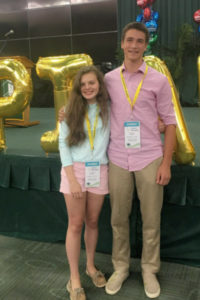
Catherine Herrick with Bradley Kerr- photo by A.-C. Herrick
Genius Olympiad, an international competition with 1100 participants representing 71 countries and 39 states, focusing on environmental issues and their solutions. The Olympiad contestants compete in one of five disciplines which include science, visual and performing arts, business, writing, and robotics, a recently added discipline.
Under the guidance of Prof. Vadas, Catherine’s topic is “The Investigation of Pharmaceutical Water Pollution Uptake in Radishes, Raphanus Sativus”, and this project finally won a Bronze medal in the science discipline. She thought this event was a wonderful experience not only because the prize she got, but also with the reason that she had this great chance to witness people from different cultures and their effort in helping the environment.–“I particularly enjoyed seeing how the participants captured their countries environmental problems in photographs and drawings in the visual arts section of the competition and in the science section.”